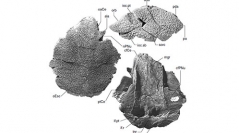

 Geodiversitas
27 (2) - Pages 201-219
Geodiversitas
27 (2) - Pages 201-219A new taxon, Bimbianga burrinjuckensis n. gen., n. sp., is erected for a small collection of acid-prepared bones from the Early Devonian (Emsian) limestones of the Burrinjuck area showing affinity with the holonematid arthrodires, a widespread brachythoracid family in the Middle-Late Devonian. The skull is represented by nuchal and paranuchal plates of holonematid shape, the nuchal overlapped by both paranuchal and central plates. Suborbital and submarginal plates show various primitive features not seen in other holonematids. Other brachythoracid submarginal plates from Burrinjuck are illustrated for comparison. The trunk armour of the new taxon is represented only by a single elongate median dorsal plate. Comparisons are made with the genus Holonema Newberry, 1889 from the Middle-Late Devonian of Europe, Russia, and the Middle East, and the best preserved material from the Gogo Formation, Western Australia. Bimbianga n. gen. is interpreted as more primitive than other holonematids in the shape of the paranuchal and suborbital plates, and the posterior angle on the median dorsal, and would be the oldest known representative of the family, although material from Khush-Yeilagh, Iran, may be of similar age.
Vertebrata, Placodermi, Arthrodira, Devonian, Australia, new genus, new species